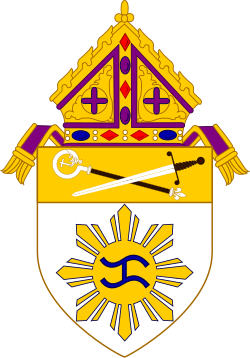Military Ordinariate of the Philippines Ordinariatus Militaris Philippinensis Ordinaryato Militar ng Pilipinas | |
|---|---|
| Catholic | |
 Saint Ignatius of Loyola Military Cathedral | |
 Coat of arms | |
| Location | |
| Country | |
| Territory | Extraterritorial to serve the: |
| Ecclesiastical province | Directly subject to the Holy See |
| Headquarters | AFP Ecumenical Building Camp General Emilio Aguinaldo, Quezon City 1110 |
| Coordinates | 14°36′42″N121°03′31″E / 14.6116478°N 121.0585394°E |
| Statistics | |
| Parishes | 75 [1] |
| Information | |
| Denomination | Catholic Church |
| Sui iuris church | Latin Church |
| Rite | Roman Rite |
| Established | December 8, 1950 |
| Cathedral | Saint Ignatius of Loyola Military Cathedral |
| Co-cathedral | Saint Joseph Pro-Cathedral (PNP) Shrine of St. Therese of the Child Jesus (diocesan) |
| Patron saint | Immaculate Conception Ignatius of Loyola John of Capistrano |
| Secular priests | 145 |
| Language | Filipino, Native Philippine regional languages, and English |
| Current leadership | |
| Pope | Leo XIV |
| Ordinary | Oscar Jaime L. Florencio |
| Vicar General | Msgr. Albert C. Songco |
| Bishops emeritus | Ramón C. Arguelles |
| Website | |
| www | |
| All current statistics are based from updated data taken by Catholic-Hierarchy.org. | |
The Military Ordinariate of the Philippines is a Latin Church ecclesiastical jurisdiction or military ordinariate of the Catholic Church in the Philippines [2] serving the Armed Forces of the Philippines, the Philippine National Police, and the Philippine Coast Guard.
Contents
- History
- Jurisdiction
- Subjects
- Territorial possessions
- Chaplains
- Non-combatant status
- Military Ordinary
- See also
- References
- External links
It has jurisdiction over all military, police, and coast guard personnel, their dependents, and civilian human resources of all branches of the armed forces. Its titular patron is the Immaculate Conception, with Ignatius of Loyola and John of Capistrano as secondary patrons.












